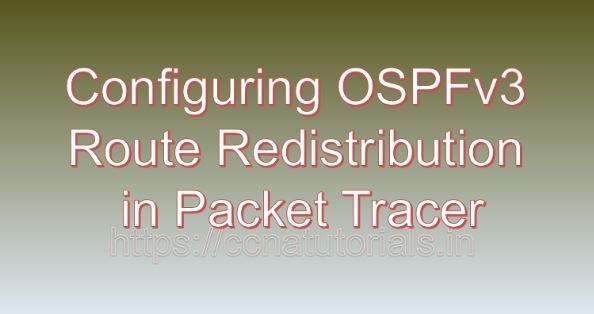Contents of this article
In this article, I describe the process of Configuring OSPFv3 Route Redistribution in Packet Tracer. In the ever-evolving landscape of networking, the seamless integration and interoperability of diverse routing protocols are essential for ensuring efficient communication and optimal network performance. Open Shortest Path First version 3 (OSPFv3) is a robust routing protocol widely used for IPv6 networks, facilitating dynamic routing and scalability. However, in heterogeneous network environments where multiple routing protocols coexist, the process of redistributing routes between OSPFv3 and other routing protocols becomes imperative. In this comprehensive guide, we will explore the concept of OSPFv3 route redistribution, discuss its significance, and provide a detailed tutorial on configuring OSPFv3 route redistribution in Cisco Packet Tracer, a versatile network simulation tool.
Understanding OSPFv3 Route Redistribution
Route redistribution is the process of exchanging routing information between different routing domains or protocols within a network. In the context of OSPFv3, route redistribution enables routers running OSPFv3 to exchange routing information with routers using other routing protocols such as RIPng (Routing Information Protocol for IPv6) or EIGRPv6 (Enhanced Interior Gateway Routing Protocol for IPv6). By redistributing routes, routers can learn about networks that are not directly connected or are advertised by other routing protocols, thus expanding the routing table and enabling more efficient path selection.
Significance of OSPFv3 Route Redistribution
The implementation of OSPFv3 route redistribution offers several significant benefits for network administrators:
- Interoperability: OSPFv3 route redistribution facilitates interoperability between OSPFv3 and other routing protocols, allowing routers running OSPFv3 to exchange routing information with routers using different protocols.
- Routing Flexibility: Route redistribution enables administrators to leverage the strengths of multiple routing protocols within the same network, providing flexibility in network design and optimization.
- Network Scalability: By redistributing routes, OSPFv3 routers can learn about networks beyond their immediate neighbors, thus enhancing network scalability and adaptability to changes in network topology.
- Path Diversity: Route redistribution introduces path diversity by allowing routers to choose the best path to a destination based on information obtained from multiple routing sources, thereby improving fault tolerance and resilience.
Configuring OSPFv3 Route Redistribution in Packet Tracer
Now, let’s delve into the practical aspect of configuring OSPFv3 route redistribution in Cisco Packet Tracer. For this demonstration, we will simulate a network topology consisting of routers running OSPFv3 and RIPng. The objective is to configure OSPFv3 route redistribution to enable routers in the OSPFv3 domain to learn routes advertised by RIPng routers.
Step 1: Create the Network Topology
Launch Cisco Packet Tracer and create a new network topology. Place two routers on the workspace, one representing the OSPFv3 domain and the other representing the RIPng domain. Connect the routers using appropriate cables, ensuring connectivity.
Step 2: Configure Router Interfaces
Access the CLI of each router and configure the interfaces connected to the network. Assign IPv6 addresses to the interfaces and enable IPv6 routing globally on each router. For example:
Router1(config)# ipv6 unicast-routingRouter1(config)# interface GigabitEthernet0/0
Router1(config-if)# ipv6 address 2001:db8:1::1/64
Router1(config-if)# no shutdown
Router1(config-if)# exitRouter2(config)# ipv6 unicast-routingRouter2(config)# interface GigabitEthernet0/0
Router2(config-if)# ipv6 address 2001:db8:2::1/64
Router2(config-if)# no shutdown
Router2(config-if)# exitStep 3: Configure OSPFv3 on Router1
Configure OSPFv3 on Router1 to advertise its connected networks. Assign Router1 as the OSPFv3 router ID and specify the network interfaces participating in OSPFv3. For example:
Router1(config)# ipv6 router ospf 1
Router1(config-rtr)# router-id 1.1.1.1
Router1(config-rtr)# exitRouter1(config)# interface GigabitEthernet0/0
Router1(config-if)# ipv6 ospf 1 area 0
Router1(config-if)# exitStep 4: Configure RIPng on Router2
Configure RIPng on Router2 to advertise its connected networks. Specify the network interfaces participating in RIPng. For example:
Router2(config)# ipv6 router rip RIPNG
Router2(config-rtr)# exitRouter2(config)# interface GigabitEthernet0/0
Router2(config-if)# ipv6 rip RIPNG enable
Router2(config-if)# exitStep 5: Configure OSPFv3 Route Redistribution
Now, configure OSPFv3 route redistribution on Router1 to redistribute routes learned from RIPng into OSPFv3. Specify the routing source and destination for redistribution. For example:
Router1(config)# ipv6 router ospf 1
Router1(config-rtr)# redistribute rip RIPNG subnets
Router1(config-rtr)# exitStep 6: Verify Configuration
Finally, verify the configuration by examining the routing tables on Router1. Use the show ipv6 route command to view the OSPFv3 routing table and ensure that routes learned from RIPng are redistributed into OSPFv3.
Router1# show ipv6 route ospfConclusion for Configuring OSPFv3 Route Redistribution in Packet Tracer
In conclusion, OSPFv3 route redistribution plays a vital role in facilitating interoperability and flexibility in heterogeneous IPv6 network environments. By configuring OSPFv3 route redistribution in Cisco Packet Tracer, network administrators can enable routers running OSPFv3 to exchange routing information with routers using other routing protocols such as RIPng, thus enhancing network scalability and adaptability. With a solid understanding of OSPFv3 route redistribution concepts and configuration procedures, administrators can effectively manage and optimize IPv6 routing in complex network infrastructures, ensuring efficient communication and optimal network performance.
As organizations continue to embrace IPv6 and deploy diverse routing protocols, the implementation of OSPFv3 route redistribution emerges as a fundamental strategy for seamless integration and interoperability across heterogeneous network environments. I hope you found this article helpful related to the process of Configuring OSPFv3 Route Redistribution in Packet Tracer. You may drop a comment below or contact us for any query or suggestions related to the contents of this website.






